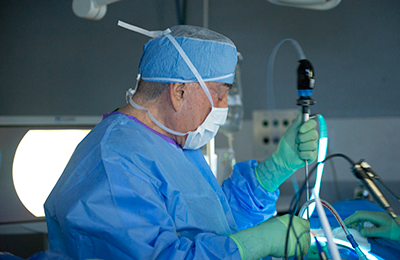Spinal Decompression Surgery
Spinal decompression surgery is performed to to treat problems associated with nerve compression due to pinched nerves, herniated discs, spinal stenosis, sciatica, degenerative disc disease. The Bonati Spine Procedures are designed to relieve the pressure on the nerves that produce symptoms such as pain, numbness, tingling or weakness. These procedures are performed on an outpatient basis, under conscious IV sedation. Once the pressure is removed off the nerves, the symptoms are alleviated and the patient can return to normal activities almost immediately.

Why Is a Spinal Decompression Surgery Done?
Conditions such as a bulging, herniated discs, bone spurs, or spondylolisthesis cause narrowing of the spinal canal and the openings through which the nerves exit the canal. This narrowing of the canals compresses the nerves as they exit the spinal canal, causing pain, numbness or weakness. If left untreated these conditions lead to more serious problems such as nerve damage or myelopathy. Spinal decompression surgery is performed in order to remove the pressure off the spinal cord or spinal nerves in order to get rid of the symptoms. Common conditions treated by this type of surgery include:
- Bulging discs
- Herniated discs
- Spinal stenosis
- Sciatica
- Facet syndrome
- Foraminal narrowing
- Pinched nerve
- Foraminal stenosis
- Spinal narrowing
- Slipped discs
How Is It Performed?
Spinal decompression surgery is the general term to refer to various surgical procedures. The way the surgeries are performed will depend on the technique used for decompression. The Bonati Spine Procedures are an array of procedure that may include:
Discectomy
A discectomy is a decompression surgery that removes the portion of the disc that’s out of its proper place and pressing on the spinal cord or nearby nerve roots, to provide symptom relief.
Laminotomy / Laminectomy
A laminectomy is a decompression surgery in which small sections of the bony arches of the spinal canal, also known as the lamina, are removed. The procedure is performed to relieve pressure in the area and give access to the spinal canal.
Foraminotomy / Foraminectomy
A foraminotomy is a decompression surgery that widens the space for the nerve roots in the spinal canal to exit. Both decompression surgeries are performed by removing tissue or bone that’s blocking the opening that nerves exit through.
Partial Facetectomy
A partial facetectomy is a decompression surgery that removes part of the facet that is pressing on nerves and/or nerve roots.
Partial Pediculectomy
A partial pediculectomy is a decompression surgery in which a small part of the pedicle that is pressing on the nerves or nerve roots is removed. Pedicles are located on each side on the vertebral body, bridging the front and back sections of each vertebra. A pediculectomy is performed to reduce symptoms caused by the thickening of ligamentum flavum (the yellow-colored ligament that connects the vertebrae in the spine).
Before Surgery
Before any spinal decompression surgery, doctors need to be sure their patients are in their best physical and mental health. This is why, in many cases before surgery doctors may ask patients to discontinue the use of medications and supplements such as:
- Muscle relaxants
- Nerve pain medications
- Analgesics
- Anti-coagulants
- Anti-depressants
- Non-steroidal anti-inflammatory drugs (NSAIDs)
During Surgery
Spinal decompression surgery at The Bonati Spine Institute is performed under local anesthesia and conscious IV sedation. Patients communicate with the surgical team during surgery and provide feedback as the pain is alleviated. The surgical team may perform specific motion and symptom-checking tests to make sure that symptoms have been successfully treated. This technique allows for higher success rates as the surgeon can make sure that the pain has been relieved prior to ending the procedure.
Spinal Decompression Surgery Recovery Time
Recovery time varies depending on the condition and the type of decompression performed. Recovery time after decompression surgery is much shorter than that of a spinal fusion. Patients are able to walk shortly after their procedures and return home that same day. Most patients are able to return to work within days after their procedures, depending on the type of work they do. Patients are expected to rest, maintain a healthy diet, avoid alcohol and smoking, and follow all post-surgery instructions provided by the surgical team.
